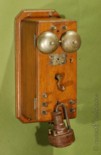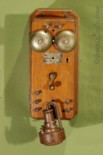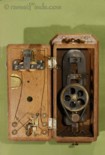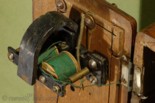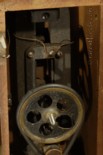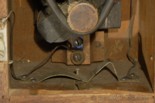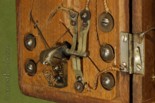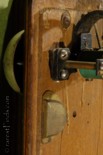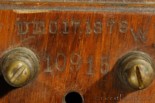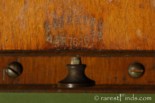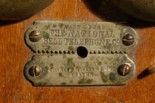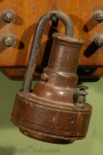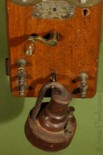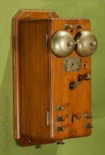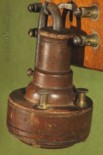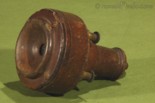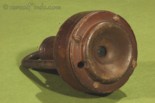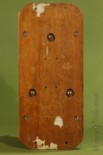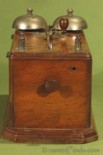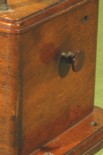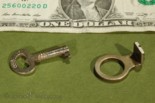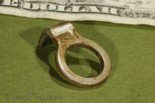First, commercially successful Telephone, built by Charles Williams for Graham Bell, the Inventor of the Telephone. Price, $9,950.
Patents, click on any image to see larger image!


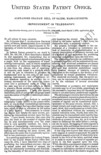
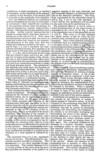


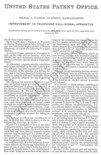
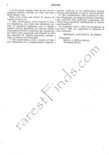

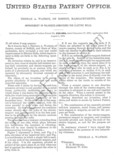
The telephone offered here for sale is an exceedingly rare and desirable "Coffin Set" Telephone manufactured by Charles Williams Jr. in Boston, Massachusetts, USA. Charles Williams built the first commercially successful telephone for The Bell Telephone Co.
On July 9, 1877, the Bell Telephone Company was organized as an unincorporated "voluntary association" without any capitalization. A strict policy of leasing instead of selling telephones was adopted. On March 13, 1879 the name changed to The National Bell Telephone Co., when New England Telephone Co., and Bell Telephone Co., merged. On April 17, 1880, National Bell Telephone Co., reached a settlement with Western Union and changed its name to American Bell Telephone Co. In March of 1885, American Telephone and Telegraph Co., (ATT) was incorporated.
The telephone offered here bears the name National Bell Telephone Co, and was therefore manufactured between March 13 1879, and May 1880. These telephones sold by the National Bell Telephone Co., used the Black transmitter with a wet-cell battery for the first time.
Alexander Graham Bell is considered the inventor of the telephone. Even so both patents imprinted on the Williams Coffin Set are actually not Bell's patents, this telephone is considered the first Bell Telephone. Two names are intricately intertwined with this first Telephone; Thomas A. Watson, who's name is on both of the patents, patent no. 202,495 issued on April 16, 1878 (see picture # 20), and patent no.210,886 issued on December 17, 1878 (see picture # 19), see patent images of both patents above. The other name is obviously Charles Williams Jr., who manufactured Bell's first telephones.
Condition:
The telephone is in "as found" condition. The many pictures show its condition better the writer could ever describe it. The receiver/transmitter has some damage to the wood as you can see in the pictures. Inside there is one broken, or de-soldered wire, coming from the door of the phone to the case of the phone at the upper hing, see picture # 4.
The wooden case is solid and nothing is lose. There is a hole in the bottom of the case on the right towards the front as shown in picture # 19 and # 20. This hole looks like it was always there, the function or purpose is however not clear. On the back of the phone seems to be some wall paper sticking to the surface of the wood; I have not tried to remove it. The Telephone seems to be complete; there was a part inside the case which is shown in the last two pictures, # 21 and # 22. I do not know whether this part belongs to this phone or not. The finish of the phone appears to be original. Metal parts do show some signs of patina or long term oxidation which is normal. There is a key with this phone to lock the front-door. Whether the key is the original one is not certain.
History:
Alexander Graham Bell, born on March 3, 1847, died on August 2, 1922, and was a Scottish-born American inventor, scientist, and engineer who is credited with inventing and patenting the first practical telephone. He also co-founded the American Telephone and Telegraph Company (AT&T) in 1885.
Both, his mother and his wife, were deaf. This profoundly influenced Bell's life. He intensely researched acoustics, sound and human hearing and speech. In 1875, Bell developed an acoustic telegraph and drew up a patent application for it. Since he had agreed to share U.S. profits with his investors Gardiner Hubbard and Thomas Sanders, Bell requested that an associate in Ontario, George Brown, attempt to patent it in Britain, instructing his lawyers to apply for a patent in the U.S. only after they received word from Britain (Britain would issue patents only for discoveries not previously patented elsewhere).
His interest and research on hearing devices eventually culminated in Bell being awarded the first U.S. patent for the telephone on March 7, 1876. Bell considered his invention an intrusion on his real work as a scientist and refused to have a telephone in his study.
Meanwhile, Elisha Gray was also experimenting with acoustic telegraphy and thought of a way to transmit speech using a water transmitter. On February 14, 1876, Gray filed a caveat with the U.S. Patent Office for a telephone design that used a water transmitter. That same morning, Bell's lawyer filed Bell's application with the patent office. There is considerable debate about who arrived first and Gray later challenged the primacy of Bell's patent. Bell was in Boston on February 14 and did not arrive in Washington until February 26.
Bell's patent 174,465, was issued to Bell on March 7, 1876, by the U.S. Patent Office. Bell's patent covered "the method of, and apparatus for, transmitting vocal or other sounds telegraphically ... by causing electrical undulations, similar in form to the vibrations of the air accompanying the said vocal or other sound." Bell returned to Boston the same day and the next day resumed work, drawing in his notebook a diagram similar to that in Gray's patent caveat.
On March 10, 1876, three days after his patent was issued, Bell succeeded in getting his telephone to work, using a liquid transmitter similar to Gray's design. Vibration of the diaphragm caused a needle to vibrate in the water, varying the electrical resistance in the circuit. When Bell spoke the sentence “Mr. Watson .. Come here .. I want to see you” into the liquid transmitter, Watson, listening at the receiving end in an adjoining room, heard the words clearly.
Although Bell was, and still is, accused of stealing the telephone from Gray, Bell used Gray's water transmitter design only after Bell's patent had been granted, and only as a proof of concept scientific experiment, to prove to his own satisfaction that intelligible "articulate speech" (Bell's words) could be electrically transmitted. After March 1876, Bell focused on improving the electromagnetic telephone and never used Gray's liquid transmitter in public demonstrations or commercial use.
The question of priority for the variable resistance feature of the telephone was raised by the examiner before he approved Bell's patent application. He told Bell that his claim for the variable resistance feature was also described in Gray's caveat. Bell pointed to a variable resistance device in his previous application in which he described a cup of mercury, not water. He had filed the mercury application at the patent office a year earlier on February 25, 1875, long before Elisha Gray described the water device. In addition, Gray abandoned his caveat, and because he did not contest Bell's priority, the examiner approved Bell's patent on March 3, 1876. Gray had reinvented the variable resistance telephone, but Bell was the first to write down the idea and the first to test it in a telephone.
The patent examiner, Zenas Fisk Wilber, later stated in an affidavit that he was an alcoholic who was much in debt to Bell's lawyer, Marcellus Bailey, with whom he had served in the Civil War. He claimed he showed Gray's patent caveat to Bailey. Wilber also claimed (after Bell arrived in Washington D.C. from Boston) that he showed Gray's caveat to Bell and that Bell paid him $100 (equivalent to $2,300 in 2019). Bell claimed they discussed the patent only in general terms, although in a letter to Gray, Bell admitted that he learned some of the technical details. Bell denied in an affidavit that he ever gave Wilber any money.
I found the following interesting information published in, The Electrical Engineer, Dec. 26, 1894, page 513:
THE TELEPHONE PATENT SITUATION-FURTHER NOTES: Now that the American Bell Telephone Co. has lost the Government case and the Berliner patent has been declared void, manufactures, before turning out battery transmitters will do well to inform themselves upon the state of the art and upon patents covering special forms of microphones as well as patents upon switching devices, used in connection with battery transmitters. Perhaps the broadest patent touching telephone circuits is that of T. A. Watson No. 202,495, dated April 16, 1878. The claims of this patent and comments thereon will be found in “The Telephone Patent Situation,” (a reprint of five articles from The Electrical Engineer, also in The Electrical Engineer of November 14, 1894. This patent already figures in two suits brought by the Western Electric Co. against one company in Boston and another in Chicago. The scope of this patent does not seem to be understood, as it appears to be generally thought that a non-infringing magneto bell will clear it. This is not the case however. Non-infringing magneto call bells have been made for years by the Viaduct Mfg. Co., of Baltimore, MD. and the Utica Fire Alarm & Electrical Co., of Utica, N. Y., and are now supplied by these companies and one or two others. The infringement of the patent above referred to consist in the combination of any magneto bell with a telephone circuit, when such combination is made in the usual way. If the magneto generator is out of circuit, or one side of the generator open, or if it is shunted out during conversation, such a combination is apparently an infringement; this is especially the case if the telephone be cut out during the operation of ringing. If, however, the magneto generator and bell are permanently in multiple across the mains of the talking circuit, and the telephone is adapted to be thrown out or in, such and organization infringes the bridging bell patent of J. J. Carty, which has been purchased by the Bell Co. It will be well for manufacturers to avoid the above described organization of circuit if they wish to avoid suit.
The broad patent on the use of the induction coil connected with a battery transmitter expires January 15, 1895.
In 1874 he obtained employment in the electrical shop of Charles Williams, Jr., at 109 Court Street, Boston. Here he met Alexander Graham Bell, and the telephone chapter in his life began. This he has told in the little book, The Birth and Babyhood of the Telephone. In 1881, having well earned a rest from the unceasing struggle with the problems of early telephony, and being now a man of means, he resigned his position in the American Bell Telephone Company and spent a year in Europe. Upon his return he started a little machine shop for his own pleasure, at his place in East Braintree, Massachusetts. From this grew te Fore River Ship and Engine Company, which did its large shore of building the U.S. Navy of the Spanish War. In 1904 he retired from active business.
Charles Williams Jr., was born in Clearmont, N.H., on March 2, 1830, in Chelmsford, Massachusetts, and died April 15, 1908. Williams was an important manufacturer of early philosophical instruments, and electrical apparatus, mainly telegraphy related. Starting in 1877, he became the first telephone manufacturer in the world producing the Coffin Set for the National Bell Telephone Co., which was founded July 9, 1877.
To read a comprehensive piece about Charles Williams Jr. and his work, click here!
Antonio Meucci, the speaking Telegraph, and the First Telephone. An article written by Angelo J. Campanella and published by ASA, Acoustic Society of America, states that Antonio Meucci described a telephone based on magnetism as early as 1854! House Resolution 269 In the House of Representatives, U.S., adopted by a two thirds vote on June 11, 2002, acknowledges Meucci as the true inventor of the telephone! To read the article, click here!
Inventory Number 09325;
Price: $ 9950.-
Prices realized in the past:
- A Williams Coffin set, without receiver/transmitter and without the magneto crank in the front (serial number 3,222, sold on eBay on January 30, 2013, for $9,468.00, click here to read about it!
- A Williams Coffin set exactly like the one offered here, with the same wooden receiver/transmitter, serial number 13,355, sold on eBay on March 4, 2016, for $11,500.00, click here to read about it!
- Another Williams Coffin Set without its receiver, serial number 644, sold on eBay in February 2018 for $13,200.00, click here to read about it!
- Yet another Williams Coffin set, or better, what was left of one, sold on eBay for $6,798.00 on March 30, 2019. Serial number 543. click here to read about it!
